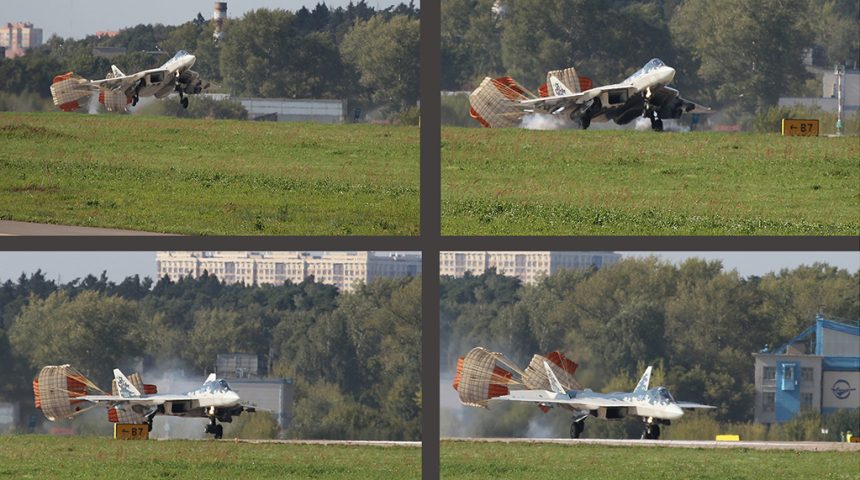Early deployment of the drag parachute is a safe practice but rarely seen.
Media day at the massive MAKS 2019 Airshow in Zhukovsky, Russia outside Moscow brought aviation journalists from around the world to the photo platform at the opposite edge of the field from airshow general audiences today.
While reporters and photographers crowded onto the massive, two-story elevated platform, at least four different Sukhoi Su-57s flew formation and solo flight demonstrations during show rehearsals on Saturday, August 24, 2019.
Russian demonstration pilots are known for their ability to push an aircraft to the outer edge of its envelope. On Aug. 24, at Zhukovsky we saw a dramatic example.
One Su-57 demo pilot made a quick approach from the far end of Zhukovsky field from the photo stand. As photographers prepared to shoot the landing and roll-out of several Su-57s in the air simultaneously, a few photographers who got set up quickly enough captured a dramatic sequence when one of the aircraft opened his drag chute while still quite a few feet above the runway.
While this is a safe practice for a qualified pilot, it is avoided in general military flying for tactical aircraft equipped with drag chutes. The minor suspension of normal landing practices did make for an interesting photo sequence though, as you can see in the four photos above.
This is what The Aviationist’s Jacek Siminski explained about the drag chute deployment before touch down commenting the video of a Polish Su-22 Fitter last year:
Drag (or drogue) chutes are a quite common design trait of the Soviet-made jets. The system consists of a single or several parachutes placed in a special pod located in the rear section of the fuselage. The chute is ejected with the use of a smaller parachute, spring-driven or compressed air based system. After the aircraft comes to a halt, the chute is separated to prevent the aircraft from being dragged on the runway. Moreover, the chute often comes with a safety system, with a ring that breaks if the braking system is deployed at a speed which is too high. In the case above probably the speed was low enough to keep the said element intact and the chute stayed in its place.
Notably, the drag created by drogue chutes is lower than the one experienced in case of the conventional drop-parachutes in order to prevent damage to the aircraft.
The one in the video is one of the techniques used to land on a damaged runway: the chute is deployed about 7 feet above the runway and the aircraft only needs 350 meters to stop.
The MAKS 2019 airshow officially opens to the public on Tuesday, August 27 and runs through Sunday, September 1, 2019 at Zhukovsky International Airport.









